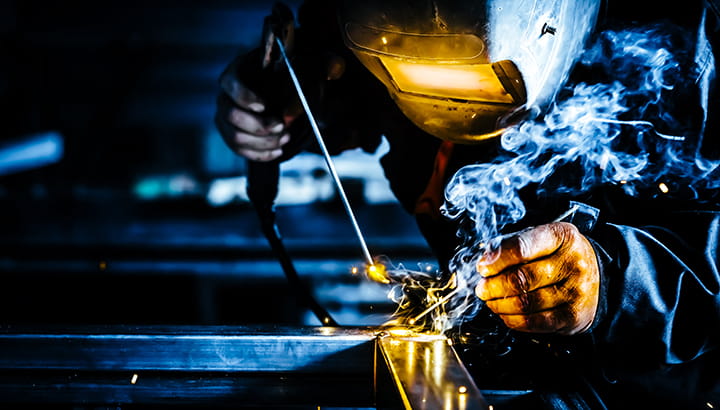
Mild steel welding is the most common method of welding today, essential to any industry that uses welding in its production process. Recent scientific evidence has indicated that the fumes generated by this process are in fact carcinogenic. While we are yet to see the full consequences of this discovery, it is evident that there is going to be an increased focus on the health and safety of welders, and the methods by which they can be guaranteed.
Welding fume is generated when a metal is heated above its boiling point. The vapors created by this thermal process condense into fine particles, essentially forming a plume suspended in the ambient air. Due to the need for accuracy, the welder will have to be close to the manual welding process. This means that the fume plume, the particles and the gases will enter the breathing zone (<30 centimeters/12 inches away from the nose and mouth) of the welder, who runs a significant risk of inhaling them.
While different welding methods give rise to different amounts of fumes, they all contain various concentrations of hazardous substances. Chrome, manganese, nickel, NOX and CO are among the most common and dangerous of these. As the smaller particles tend to end up deeper inside the lungs when inhaled, they are – along with the gases – considered to pose the greatest health risk.
In April 2017, IARC – the International Agency for Research on Cancer – released new scientific evidence showing that mild steel welding fume can cause lung cancer (and likely also kidney cancer) in humans. The most immediate legislative result of this was that mild steel welding fume was reclassified as a human carcinogen in the United Kingdom by the Health and Safety Executive (HSE), an agency dedicated to workplace safety.
As general venting does not achieve the necessary emissions control, the HSE has issued a change in enforcement expectations, meaning that all businesses undertaking welding activities must ensure effective engineering controls in order to prevent workers from welding fume exposure. “Regardless of duration, HSE will no longer accept any welding undertaken without any suitable exposure control measures in place, as there is no known level of safe exposure.” (Source: www.hse.gov.uk)
Legislation regarding workplace safety requirements varies considerably between nations. Within Europe, however, the European Union sets certain minimum requirements with which its member states must comply. These requirements concern a variety of workplace factors, including air quality and limit values on certain hazardous substances. Many countries have legislation that has met these requirements for years, but the recent development in the United Kingdom is arguably a significant step toward stricter regulations on mild steel welding. Other countries, most recently Germany, have taken legislative steps that indicate that they too are likely to impose stricter welding fume legislation in the near future.
At-source extraction (also known as at-source capture) has been found to be the most effective way of collecting and removing fumes. That said, the best solution can still be portable, stationary, central or customized, depending on the welding process and the environment in which it takes place. The Nederman Fume Eliminator is an example of a product that can easily be moved and carried around within a factory or workshop for the purpose of short time welding. Stationary devices – such as extraction arms and extraction reels, or welding and grinding tables – remain the most common means of fume extraction, and will continue to be, as they will replace recirculating systems in several long time welding operations.
While it is difficult to make predictions about future welding legislation, there are other predictions we can make about industrial welding itself. Whereas many welding processes used to involve several different segments, it is today much easier to have a more multifaceted welding process. This involves complex movements and multiple parts being welded together at a single production stage – supported by tailor-made at-source fume extraction – or creating a product in a 3D-printing process as one, single part.
We can also expect robotic welding to become more and more common. In order to maintain cleanliness and quality of performance, these welding robots require fume extraction systems as well. Both the robot and the welding surface need to be clean in order for the robot to do its job with proper precision. Also, human workers will need to be able to access these robots when conducting maintenance and adjustment work, meaning that the air inside the robots’ environment will have to be free of carcinogens and other dangerous particulates.
Both trends support the development we are already seeing, where new generations of welders question old habits and work culture, and demand a safer and cleaner work environment.
Companies that install efficient fume extraction systems can often tell the difference very quickly, as their factories and workshops become noticeably cleaner when these fumes are extracted properly. Such an environment will result in healthier workers, lead to less sick leave, and prevent early retirement. Businesses with safe and clean working conditions also tend to see improvements such as higher productivity, higher product quality, and an increased likelihood in attracting (and keeping) highly skilled personnel.
If you want to know more about welding fume extraction, feel free to read my colleagues’ blog posts on robotic welding and dust and fume extraction in a 3D printing work environment, here in the Nederman Knowledge Center. You can also read more about Nederman’s products here.
We have extensive experience of various challenges in the different industries and our experts are very skilled, helpful and professional. With us, you can feel secure that we take care of you and your needs. You are always welcome to contact us regardless if you have a short question or a more complex and complicated one. A warm welcome to Nederman.
Contact us here